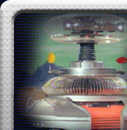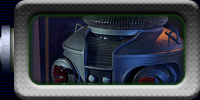




 |
|
| Robot Reference->Construction Tips->LED Brain Lighting | |||
By John Levenick I decided
when I started building my 3˜4 scale B9 to start from the top down.
This is backwards of how many builders do it. Naturally the brain
was the first thing I tackled.
LEDs use little current, and generate almost no heat, especially when properly biased. The problem was getting them to blink in a pleasing manner. I have included the schematic I chose to use. It is fairly basic, and, while not random, it is very flexible. properly done can appear random except under scrutiny. LEDs
are currently available in almost every basic color, giving you
more than a few choices. I went with a multicolor scheme. To me,
it was the most pleasing option.
The rails are mounted about 1˜4 inch behind the sides of the brain with a bead of goop. The LEDs are press fit into the holes, and soldered to a common ground buss line. Individual LEDs are addressed by the outputs of the decade counter through rainbow ribbon cable. (I have included a scan of the actual brain wireing, however, it did not turn out as well as I would have liked.) The three separate sets of LEDs are wired in parallel, so one on each side flashes at a time. Since my scaled version could not accommodate a cam drive type device to animate the light rods, (couldnít find a suitable size motor) I decided to tap the first and last output lines to light LEDs mounted in the light rods. The effect is not as spectacular as moving light rods, but at least they are semi-functional.
B-9
Brain Light Schematic Parts List/Notes The pattern of the display can be varied by changing the output lines to the display. Experiment on a solderless circuit board for the most pleasing effect. It is recommended that this (or any) circuit be tried out on a solderless board first, so component values can be selected or changed. The reason I specify any color except blue ore white is that these kinds of LEDs have a significantly higher forward voltage (3.2-3.7V) compared to other kinds of LEDs. While this circuit may be able to drive them without pull up transistors, I have not tested it for this. This circuit has been successfully tested to drive three full sets of LEDs in parallel, for a total of 30 LEDs, flashing 3 at a time. The datasheet on the 4017 states that it can handle up to 15Vdc, however, I have only tested this circuit up to 12V. The outputs of the 4017 could easily be used to drive 12V lamps with the addition of pull up transistors, however I have not included a diagram for this. The wiring for such is left to the builder.
|
|||








 LED
Brain Lighting
LED
Brain Lighting

